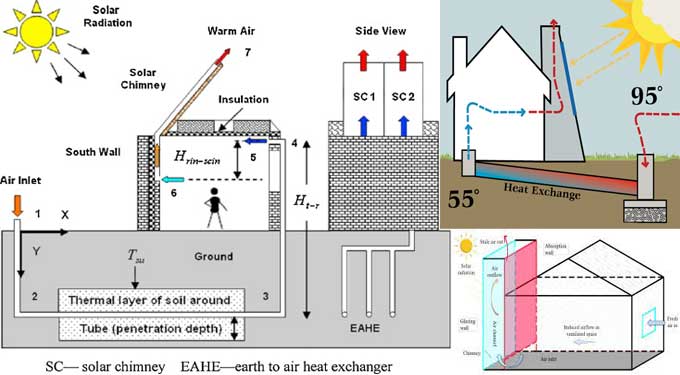NEWS | SOFTWARE | SHEET
A Brief Introduction on Solar Chimney & its Importance
Humanity relies heavily on energy to maintain global environmental and economic sustainability as conventional energy sources are depleting steadily.
Various devices have been used to harness solar power, including photovoltaic cells, concentrated troughs, etc. The installation of these devices requires a large amount of land. As a result, the ground would be particularly barren. Energy can be used in conjunction with land cultivation as a viable option. A solar chimney can be used to meet such an objective to some extent.
Define Solar Chimney
Solar chimneys are passive solar heating and cooling systems used to heat and cool a building and provide ventilation. Solar chimneys are a form of energy-efficient building design, like Trombe walls and solar walls.
Passive cooling and heating systems such as solar chimneys regulate temperature in buildings, improve ventilation, and increase fire safety. The system adjusts indoor temperatures based on environmental factors such as solar radiation, night breezes, and air pressure differences.
Workflow of Solar Chimney
Thermal chimneys release heat at the time when the air inside heats up from the sun. Having cooler air from below entering the chimney creates ventilation throughout the building.
Using solar radiation or heat energy, the solar chimney is one of the technologies that use buoyancy to heat air through the greenhouse effect. An external or internal solar chimney is a passive outdoor ventilation system that does not require mechanical components. By replacing interior warm air with exterior cool air, these chimneys reduce unwanted heat during the day using the convective cooling principle.
Black, hollow thermal mass chimneys have an opening at the top that allows hot air to exit. The top of the chimney is where the air in the room exits. It is also possible to reverse the process for heating a room.
Efficiency of Solar Chimney
Placement of a solar chimney in a building's structure determines its effectiveness. The solar panel should be placed in a location in the building that receives maximum heat from the afternoon sun.
To maintain a comfortable temperature within the building during the winter, the thermal chimney can be closed. Thermal chimney size plays an important role in its effectiveness; the larger the chimney, the greater the efficiency. If a house is built in the northern hemisphere, a solar chimney should be placed on the south-facing wall.
Importance of Solar Chimney
Buildings are connected to the outside by thermal chimneys, which are hollow vertical structures. The air in the chimney circulates outside as it heats up and shrinks in density, leaving a space inside that is not filled with air. In turn, this encourages the high-density, cooler air from the base to flow into the solar chimney, which eventually leads to the building being ventilated.
With renewable energy sources such as solar, biomass, wind, etc., clean electricity can be generated. There are many countries that have adequate sunlight throughout the year and enough land to receive sunlight, and solar energy is one of the untapped energy sources. Solar power has been harnessed extensively in India in the past few years.
Materials for constructing Solar Chimney
It is important to design a solar chimney carefully, and its construction material should be able to absorb the maximum amount of heat; otherwise, the solar chimney may not be able to perform correctly.
As the materials used for constructing a solar chimney affect its effectiveness, they should be carefully chosen. A solar chimney needs materials with high heat-absorbing properties, such as tinted glass, insulated glazing, bricks, and metals.
Features of Solar Chimney
Multi-flapped absorber plate
Some existing chimney-type collectors have multi-flapped absorber plates with unequal insulation, and adjacent flaps cast shadows.
To get more clear ideas, go through the following exclusive construction video tutorial.
Lecturer: EMMANOUIL MAGKARIS
Back Insulation
The collector does not have back insulation. In addition to eliminating back insulation losses, this feature contributes to greater heat transfer efficiency by absorbing radiation on both sides of the plate and transferring it to the air.
Cylindrical Glazing
Cylindrical glazing makes it different from flat cover glazing in terms of transmittance-absorptance coefficient.
Merits of Solar Chimney
- Energy costs can be reduced by 50%.
- Increases evacuation time during a fire, saving lives.
- The cost of construction is low.
- The cost of maintenance is low.
- A vent opening can be adjusted to control ventilation.


